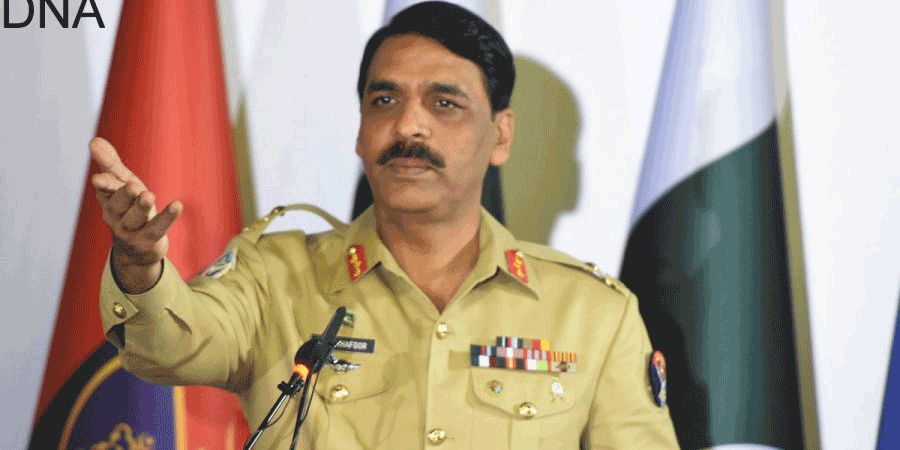Memories of Another Day
By Imdad Hussain | Cover Story | Published 6 years ago
Major General Asif Ghafoor, DG ISPR, did not mince his words while stating the following at a press conference in April 2019: “People are saying that perhaps the media is being controlled by the the ISPR, or the military, but I have rebuffed [this perception] many times… can any anchor claim that he or she was asked to abstain from speaking on certain issues, or was made to highlight a particular issue?”
Major Ghafoor didn’t stop there; he thanked and praised the Pakistani media for its role in the war on terror over the past two decades, and during the three-day conflict with India in February. He went on to say that had today’s media existed in 1971, Pakistan would not have been divided.

Major Ghafoor at a press conference.
After his unexpected reference to 1971, a few journalists mentioned the name of Anthony Mascarenhas, an assistant editor with Morning News, Karachi, and the author of an article titled ‘Genocide’ in the same newspaper – an informative account of what really happened in East Pakistan. It was a report on the human rights violations in that part of the country. In fact, if such truthful reports were published earlier, corrective measures could have been taken and the break-up averted. As a matter of fact, nobody dared to report the reality, as there were strict restrictions on the flow of information. Mascarenhas could dare to do so only because he had shifted to London permanently before the article was published. He died in London in 1986. His article might have been cited by India and used as a pretext to justify its intervention in Pakistan’s internal affairs, leading to the emergence of Bangladesh, but no one can deny that the situation was not created by the writer – he was merely reflecting it.
The past aside, is it sensible/possible to report on core security issues today? This would serve as an accurate gauge of whether present-day Pakistan is any different for the media than that which existed in 1971 and earlier. Finding an answer to this question isn’t easy.
Like Mascarenhas, we have the case of another reporter – in today’s Pakistan – Cyril Almeida. He was branded a traitor, his name was put on the Exit Control List and a case of treason was registered against him following the Dawn leaks controversy. Further pressure was mounted on Almeida after his interview with former prime minister, Nawaz Sharif, who spoke of Pakistan’s soil being used against other states by militants (more specifically, the Mumbai blast). After the interview was published last year, the National Security Council held a meeting to deliberate on the interview. Subsequently, a civil society member filed a petition against him. A court trial against the interviewer and interviewee is still going on.
Interestingly, there was nothing new in the interview, especially for those keeping themselves abreast of the situation in the country. Former DG FIA, Tariq Khosa, had already written an article, discussing the use of Pakistani soil for the Mumbai attacks in Dawn’s August 3, 2015 edition. Moreover, many people, including the former president, General (R) Pervez Musharraf, had spoken on the issue of cross-border terrorism, on several occasions. Further, Pakistan had launched several operations against militants and secured formerly ungoverned areas for establishing peace in the region.
Despite all the above facts, a case was built against the journalist. This one incident against the reporter of one of Pakistan’s most credible newspapers, put the media, in general, on the back foot and it increasingly began resorting to self-censorship, in addition to facing the restrictions being imposed by certain institutions.

Anthony Mascarenhas’ report in the Morning News, was an informative account of what transpired in East Pakistan, in 1971.
A more recent case is that of journalist Shahzeb Jillani, who had been booked for his remarks on missing persons, in a TV show. The complaint was filed by a habitual petitioner.
The questions raised by Jillani were not new either, as state institutions had been asked the same by several courts in the missing persons cases. These institutions are subject to the law and they can not simply brush aside the accusations by presenting a select few facts and figures.
Only last year, journalist Gul Bukhari was abducted in Lahore by unknown persons for a few hours and released following an uproar on social media. All these are being viewed as tactics to silence certain voices in the media. Over the last one year, several journalists have complained that their articles were not allowed to be published in assorted newspapers. If this situation persists, the media would be forced to step back the way it did in the 1970s and the ’80s – when nobody dared to touch any controversial topics – and ended up losing its credibility. This could sound the death knell for press freedom.
The recent conflict with India has shown us the significance of a credible media in times of crises – the Indian media learnt its lesson the hard way. Do we want the Pakistani media to be reduced to the same sorry state?
The military spokesman may be right when he says that his institution is no longer directly intervening in the media’s internal affairs. But if the state is indeed on the side of the independent media as a source of information, why is the media feeling so pressured? And why are certain media persons being abducted or intimidated, causing other journalists to impose limitations on themselves?
The state comprises several other institutions, including the judiciary, the FIA and the government. In the last two years, the owners, editors and reporters of media houses are being summoned by the courts more frequently. Consequently, any criticism of certain institutions in the media is gradually vanishing.
Incidentally, the media is beset with not just issues of press freedom. The most pressing problem is that of finances. Every media house has had to resort to downsizing, resulting in unemployment for hundreds. While it is true that a portion of the advertising has shifted to digital and social media, the media houses are accusing the government of partiality in the distribution of ads. Certain media outlets are being given preference over others, in the disbursement of advertisements, while others are being pushed to the wall. However, questions are being raised about why newspapers, magazines and TV channels continue to be launched when the financial situation of the market is so critical.
The fact is that the state of Pakistan does not appear to be fully cognisant of the concept of freedom of expression and a free media. All state institutions and national players need to be sensitised to the concept. Fortunately, the DG ISPR has publicly acknowledged the fact that controlling the media could have negative repercussions for the country, as was seen in the Middle East during the Arab spring.
Only a credible and vibrant media that has the confidence of the public, can play a positive role in society. But to retain its credibility, the media needs freedom from external pressure, interference and intimidation. Moreover, it needs to be financially viable.
Despite all its limitations, the Pakistani media stood up to Musharraf, a military dictator, in 2007 and forcefully challenged his legacy. And it was the pressure of the media that helped restore Chief Justice Iftikhar Chaudhry to his position.
On several occasions, Pakistan’s approach to the Afghan issue and its foreign and security policies, were challenged by media, without any major hindrance or threat. Additionally, the media questioned the former army chief, General (R) Raheel Sharif’s appointment as head of the Saudi Coalition forces and opposed the proposal to send troops to Yemen.
For all its candour and vibrancy, Pakistan occupies the 139th position on the press freedom index of the world, and major steps need to be taken to improve its ranking.


